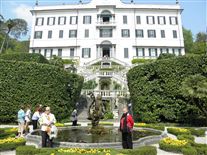P4190315.jpg
Villa Carlotta - Click 'Details' for more information
History:
The building of the villa was begun in 1690 by the Milanese Giorgio II Clerici (1648-1736). The Clerici family, originally from the north of the Como Lake area, accumulated a great richness thanks to the textile trades of Giorgio I (1575-1660) and his sons Pietro Antonio (1599-1675), who was titled as Marquis, and Carlo (1615-1677) who became owner of numerous palaces in Milan and Brianza. Carlo's son, Giorgio II inherited fabulous richness and an important social position; he became senator in 1684 and in 1717 he was nominated as President of the Senate. He conceived the villa in Tremezzo as a real manifesto of his family success. His 21 years old great-grand son Antonio Giorgio (1715-1768) inherited his immense fortune and completed the building of the villa.
Antonio Giorgio, Baron of Sozzago, Marquis of Cavenago, Knight of the Golden Fleece and Milanese patrician had an intense life: charming, owner of a regiment of infantry, generous and squandered, collector of masterpieces of art (he ordered, for example, to Tiepolo the frescos for his house in Milan) he died in 1768, after having dissipated all his richness. Claudia, Antonio Giorgio's daughter and Earl Vitagliano Bigli's wife, was the last of the Clericis to own the villa in Tremezzo. She sold it to Gian Battista Sommariva in 1801.
During the World War I , Villa Carlotta was not sequestered by the Italian State, as the other properties of enemy subjects in Italy, but placed under the managements of an administrator. After the end of the war the building risked to be sold in a auction in favour of the Opera Nazionale Combattenti. Thanks to the strong will of senator Giuseppe Bianchini and the Rotary Club of Milan, the villa was finally entrusted to the Ente Villa Carlotta, a foundation especially constituted by a royal decree on 12 Mai 1927. This foundation still nowadays takes care of the villa in Tremezzo and uses all the amounts of the entrance fees for the maintenance and the conservation of the building, the works of art and the gardens.
